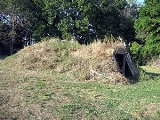
Earth lodge
Encyclopedia
An earth lodge is a semi-subterranean building covered partially or completely with earth, best known from the Native American
cultures of the Great Plains
and Eastern Woodlands. Most earth lodges are circular in construction with a dome-like roof, often with a central or slightly-offset smoke hole at the apex of the dome. Earth lodges are well-known from the more-sedentary tribes of the Plains such as the Hidatsa
, Mandan, and Arikara
, but they have also been identified archaeologically
among sites of the Mississippian culture
in the Eastern United States.
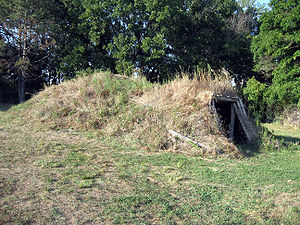 Earth lodges were typically constructed using wattle and daub
Earth lodges were typically constructed using wattle and daub
technique, with a thick coating of earth. The dome-like shape of the earth lodge was achieved by the use of angled (or carefully bent) tree trunks, although hipped roof
s were also sometimes used. During construction the workers would dig an area a few feet beneath the surface, allowing the entire building to have a floor somewhat beneath the surrounding ground level. They set posts into holes in the ground around the edges of the earth lodge, and made the tops meet in (or near) the middle. This construction technique is sturdy and can produce large buildings (some as much as 60 feet (18.3 m) across), in which more than one family would live. Their size is limited by the length of available tree trunks. Internal vertical support posts were sometimes used to give additional structural support to the roof rafters.
After a strong layer of sticks (or reeds) was wrapped through and over the radiating roof timbers, the people often applied a layer of thatch as part of the roof. The structure was then entirely covered in earth. The earth layer (and the partially-subterranean foundation) provided insulation
against the extreme temperatures of the Plains.
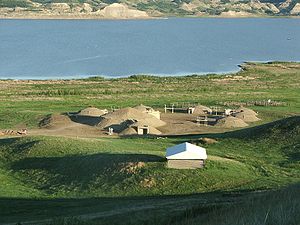 Earth lodges were a common dwelling for Native American tribes of the upper Midwest (specifically the Mandan, the Hidatsa and the Arikara). The origin of the upper-Midwest earth lodge is generally attributed to the Mandan tribe, who were sedentary farmers and traders. When the Hidatsa later arrived in the area, they adopted the earthen structures. The Arikara (a Caddoan-speaking Pawnee tribe) built earth lodges long before they arrived in North Dakota. These structures were a familiar sight to traders and explorers along the banks of the Little Missouri, and were found in city clusters of up to a thousand such homes.
Earth lodges were a common dwelling for Native American tribes of the upper Midwest (specifically the Mandan, the Hidatsa and the Arikara). The origin of the upper-Midwest earth lodge is generally attributed to the Mandan tribe, who were sedentary farmers and traders. When the Hidatsa later arrived in the area, they adopted the earthen structures. The Arikara (a Caddoan-speaking Pawnee tribe) built earth lodges long before they arrived in North Dakota. These structures were a familiar sight to traders and explorers along the banks of the Little Missouri, and were found in city clusters of up to a thousand such homes.
These structures consisted of a clay outer shell over an inner shell of long grasses and a woven willow ceiling. The middle of the earth lodge was used as a fire pit, and a hole was built into the center. This smoke hole was often covered by a bullboat during inclement weather. Logs were gathered each spring as the ice receded and sheared them off; fresh logs were also cut. The most common wood used was cottonwood. Cottonwood was a wet, soft wood; this meant that lodges often required rebuilding every six to eight years.
Men only raised the large logs; the rest of the work was done by women. Therefore, a lodge was considered to be owned by the woman who built it. A vestibule of exposed logs marked the entrance and provided an entryway; these vestibules were often a minimum of 6 to 9 ft (1.8 to 2.7 m) in length (determined by the size of the lodge and resulting outer-clay thickness). A windbreak was built on the interior of the lodge, blocking the wind and giving privacy to the occupants. Earth lodges often also contained cache pits (root cellar-type holes) lined with willow and grasses, within which dried vegetables were stored.
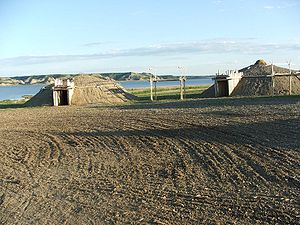 Earth lodges were often found alongside tribal farm fields, alternating with tipis (which were used during the nomadic hunting season). A reconstructed earth lodge can be seen at the Glenwood, Iowa Lake Park; an earth-lodge village may be seen at New Town, North Dakota. The village consists of six family-sized earth lodges and one large ceremonial lodge. In addition, a garden area and corrals have been built for authenticity. The park is open to the public and located west of New Town at the Earthlodge Village Site. The family earth lodges are roughly 40 feet (12.2 m) in diameter. The ceremonial earth lodge is more than 90 feet (27.4 m) in diameter, the largest such structure in the world. The park is the central point in a rebuilding and cultural renewal effort by the three affiliated tribes of the Fort Berthold Indian Reservation. This is the only village of its kind to be constructed by the Mandan, Hidatsa and Arikara Nations in over 100 years.
Earth lodges were often found alongside tribal farm fields, alternating with tipis (which were used during the nomadic hunting season). A reconstructed earth lodge can be seen at the Glenwood, Iowa Lake Park; an earth-lodge village may be seen at New Town, North Dakota. The village consists of six family-sized earth lodges and one large ceremonial lodge. In addition, a garden area and corrals have been built for authenticity. The park is open to the public and located west of New Town at the Earthlodge Village Site. The family earth lodges are roughly 40 feet (12.2 m) in diameter. The ceremonial earth lodge is more than 90 feet (27.4 m) in diameter, the largest such structure in the world. The park is the central point in a rebuilding and cultural renewal effort by the three affiliated tribes of the Fort Berthold Indian Reservation. This is the only village of its kind to be constructed by the Mandan, Hidatsa and Arikara Nations in over 100 years.
Use by the Mississippian culture
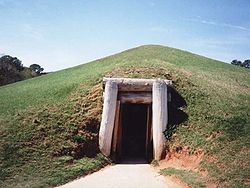 A number of major Mississippian mound
A number of major Mississippian mound
centers have identified earth lodges, either beneath (i.e. preceding) mound construction or as a mound-top building. Sequential constructions, collapses, and rebuilding of earth lodges seems to be part of the mechanism of construction for certain mounds (including the mound at Town Creek Indian Mound
and some of the mounds at the Ocmulgee National Monument
). In Kanabec County, Minnesota the Groundhouse River flows. According to Newton H. Winchell in The Aborigines of Minnesota, the river was named for the earth lodges of the Hidatsa
, who lived in the area before being driven westward to the Missouri River
by the Sioux
. The Hidatsa lived in wooden huts, covered with earth.
Native Americans in the United States
Native Americans in the United States are the indigenous peoples in North America within the boundaries of the present-day continental United States, parts of Alaska, and the island state of Hawaii. They are composed of numerous, distinct tribes, states, and ethnic groups, many of which survive as...
cultures of the Great Plains
Great Plains
The Great Plains are a broad expanse of flat land, much of it covered in prairie, steppe and grassland, which lies west of the Mississippi River and east of the Rocky Mountains in the United States and Canada. This area covers parts of the U.S...
and Eastern Woodlands. Most earth lodges are circular in construction with a dome-like roof, often with a central or slightly-offset smoke hole at the apex of the dome. Earth lodges are well-known from the more-sedentary tribes of the Plains such as the Hidatsa
Hidatsa
The Hidatsa are a Siouan people, a part of the Three Affiliated Tribes. The Hidatsa's autonym is Hiraacá. According to the tribal tradition, the word hiraacá derives from the word "willow"; however, the etymology is not transparent and the similarity to mirahací ‘willows’ inconclusive...
, Mandan, and Arikara
Arikara
Arikara are a group of Native Americans in North Dakota...
, but they have also been identified archaeologically
Archaeology
Archaeology, or archeology , is the study of human society, primarily through the recovery and analysis of the material culture and environmental data that they have left behind, which includes artifacts, architecture, biofacts and cultural landscapes...
among sites of the Mississippian culture
Mississippian culture
The Mississippian culture was a mound-building Native American culture that flourished in what is now the Midwestern, Eastern, and Southeastern United States from approximately 800 CE to 1500 CE, varying regionally....
in the Eastern United States.
Structure

Wattle and daub
Wattle and daub is a composite building material used for making walls, in which a woven lattice of wooden strips called wattle is daubed with a sticky material usually made of some combination of wet soil, clay, sand, animal dung and straw...
technique, with a thick coating of earth. The dome-like shape of the earth lodge was achieved by the use of angled (or carefully bent) tree trunks, although hipped roof
Hipped roof
Hipped roof can refer to:*A hip roof, a type of roof where all sides are sloped*A tented roof, a conical style of roof seen in Russian architecture...
s were also sometimes used. During construction the workers would dig an area a few feet beneath the surface, allowing the entire building to have a floor somewhat beneath the surrounding ground level. They set posts into holes in the ground around the edges of the earth lodge, and made the tops meet in (or near) the middle. This construction technique is sturdy and can produce large buildings (some as much as 60 feet (18.3 m) across), in which more than one family would live. Their size is limited by the length of available tree trunks. Internal vertical support posts were sometimes used to give additional structural support to the roof rafters.
After a strong layer of sticks (or reeds) was wrapped through and over the radiating roof timbers, the people often applied a layer of thatch as part of the roof. The structure was then entirely covered in earth. The earth layer (and the partially-subterranean foundation) provided insulation
Thermal insulation
Thermal insulation is the reduction of the effects of the various processes of heat transfer between objects in thermal contact or in range of radiative influence. Heat transfer is the transfer of thermal energy between objects of differing temperature...
against the extreme temperatures of the Plains.
Use by Plains Native Americans

These structures consisted of a clay outer shell over an inner shell of long grasses and a woven willow ceiling. The middle of the earth lodge was used as a fire pit, and a hole was built into the center. This smoke hole was often covered by a bullboat during inclement weather. Logs were gathered each spring as the ice receded and sheared them off; fresh logs were also cut. The most common wood used was cottonwood. Cottonwood was a wet, soft wood; this meant that lodges often required rebuilding every six to eight years.
Men only raised the large logs; the rest of the work was done by women. Therefore, a lodge was considered to be owned by the woman who built it. A vestibule of exposed logs marked the entrance and provided an entryway; these vestibules were often a minimum of 6 to 9 ft (1.8 to 2.7 m) in length (determined by the size of the lodge and resulting outer-clay thickness). A windbreak was built on the interior of the lodge, blocking the wind and giving privacy to the occupants. Earth lodges often also contained cache pits (root cellar-type holes) lined with willow and grasses, within which dried vegetables were stored.

Use by the Mississippian cultureMississippian cultureThe Mississippian culture was a mound-building Native American culture that flourished in what is now the Midwestern, Eastern, and Southeastern United States from approximately 800 CE to 1500 CE, varying regionally....

Mound
A mound is a general term for an artificial heaped pile of earth, gravel, sand, rocks, or debris. The most common use is in reference to natural earthen formation such as hills and mountains, particularly if they appear artificial. The term may also be applied to any rounded area of topographically...
centers have identified earth lodges, either beneath (i.e. preceding) mound construction or as a mound-top building. Sequential constructions, collapses, and rebuilding of earth lodges seems to be part of the mechanism of construction for certain mounds (including the mound at Town Creek Indian Mound
Town Creek Indian Mound
-External links:*, North Carolina Historic Sites...
and some of the mounds at the Ocmulgee National Monument
Ocmulgee National Monument
Ocmulgee National Monument preserves traces of over ten millennia of Southeastern Native American culture, including major earthworks built more than 1,000 years ago by Mississippian culture peoples: the Great Temple and other ceremonial mounds, a burial mound, and defensive trenches...
). In Kanabec County, Minnesota the Groundhouse River flows. According to Newton H. Winchell in The Aborigines of Minnesota, the river was named for the earth lodges of the Hidatsa
Hidatsa
The Hidatsa are a Siouan people, a part of the Three Affiliated Tribes. The Hidatsa's autonym is Hiraacá. According to the tribal tradition, the word hiraacá derives from the word "willow"; however, the etymology is not transparent and the similarity to mirahací ‘willows’ inconclusive...
, who lived in the area before being driven westward to the Missouri River
Missouri River
The Missouri River flows through the central United States, and is a tributary of the Mississippi River. It is the longest river in North America and drains the third largest area, though only the thirteenth largest by discharge. The Missouri's watershed encompasses most of the American Great...
by the Sioux
Sioux
The Sioux are Native American and First Nations people in North America. The term can refer to any ethnic group within the Great Sioux Nation or any of the nation's many language dialects...
. The Hidatsa lived in wooden huts, covered with earth.
See also
- AdobeAdobeAdobe is a natural building material made from sand, clay, water, and some kind of fibrous or organic material , which the builders shape into bricks using frames and dry in the sun. Adobe buildings are similar to cob and mudbrick buildings. Adobe structures are extremely durable, and account for...
- Earth houseEarth houseAn earth house is an architectural style characterized by the use of natural terrain to help form the walls of a house. An earth house is usually set partially into the ground and covered with thin growth...
- HoganHoganA hogan is the primary traditional home of the Navajo people. Other traditional structures include the summer shelter, the underground home, and the sweat house...
- KivaKivaA kiva is a room used by modern Puebloans for religious rituals, many of them associated with the kachina belief system. Among the modern Hopi and most other Pueblo peoples, kivas are square-walled and underground, and are used for spiritual ceremonies....
- Quiggly holeQuiggly holeA quiggly hole, also known simply as a quiggly or kekuli, is the remains of an underground house built by the First Nations people of the Interior of British Columbia and the Columbia Plateau in the U.S....
- TipiTipiA tipi is a Lakota name for a conical tent traditionally made of animal skins and wooden poles used by the nomadic tribes and sedentary tribal dwellers of the Great Plains...
- WigwamWigwamA wigwam or wickiup is a domed room dwelling used by certain Native American tribes. The term wickiup is generally used to label these kinds of dwellings in American Southwest and West. Wigwam is usually applied to these structures in the American Northeast...

